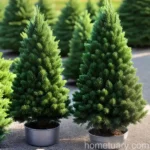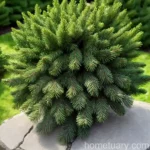The Beauty of Dwarf Norway Spruce (Picea abies ‘Elegans’)

When it comes to enhancing the aesthetic appeal of your garden or landscape, few plants can rival the charm and elegance of the dwarf Norway spruce (Picea abies ‘Elegans’). This exquisite conifer adds a touch of sophistication with its compact size and graceful conical shape. In this comprehensive guide, we will delve into the intricacies of caring for this enchanting plant, exploring its culture, uses, care requirements, and so much more. Let’s embark on a journey to discover the captivating world of the dwarf Norway spruce.
What Is a Dwarf Norway Spruce (Picea abies ‘Elegans’)?
Overview
The Picea abies ‘Elegans’, commonly known as the dwarf Norway spruce, is a slow-growing, compact conifer that belongs to the Pinaceae family. This evergreen tree is a cultivar of the Norway spruce (Picea abies) and is renowned for its elegant, dense foliage and graceful form.
Appearance
The Picea abies ‘Elegans’ is distinguished by its striking blue-green needles that radiate a captivating silvery sheen. The conical shape of the tree and its compact growth habit make it a perfect choice for small gardens, containers, and rockeries. The dwarf Norway spruce is adored for its year-round beauty and ability to thrive in various landscape settings.
Key Takeaways – Dwarf Norway Spruce (Picea abies ‘Elegans’)
Before we delve into the intricate care practices for the dwarf Norway spruce, let’s highlight some key takeaways about this captivating plant.
Culture
- The dwarf Norway spruce is a slow-growing conifer that thrives in cool climates.
- It is renowned for its compact size, making it a popular choice for small gardens and container planting.
- This conifer is prized for its elegant, conical shape and striking blue-green foliage.
Uses
- The Picea abies ‘Elegans’ is commonly used for ornamental purposes, adding charm to gardens, container plantings, and rockeries.
- Its compact size and slow growth make it an ideal choice for small spaces, urban landscapes, and perennial borders.
Water
- The dwarf Norway spruce requires regular watering, particularly during dry spells, to maintain adequate soil moisture.
Sunlight
- This conifer thrives in full sun to partial shade, although it performs best in locations with ample sunlight.
Fertilizer
- The Picea abies ‘Elegans’ benefits from a balanced, slow-release fertilizer applied in spring to support healthy growth.
Soil
- It prefers well-draining, acidic soil with good moisture retention. Amending the soil with organic matter can enhance its growth and vitality.
Pruning
- Pruning is minimal for the dwarf Norway spruce, primarily focusing on the removal of dead or damaged branches to maintain its aesthetic appeal.
Propagation
- Propagation is commonly achieved through semi-hardwood cuttings, offering a reliable method to propagate new plants.
Container Popularity
- The compact size and slow growth habit of the dwarf Norway spruce make it a popular choice for container planting, allowing individuals with limited space to enjoy its beauty.
Common Diseases
- The Picea abies ‘Elegans’ may be susceptible to certain diseases such as needle cast and root rot, requiring proactive management practices to maintain its health.
Common Pests
- While relatively pest-resistant, the dwarf Norway spruce may encounter issues with spider mites, aphids, and spruce gall adelgids.
Botanist’s Tips
- To ensure the optimal growth and vitality of the dwarf Norway spruce, it is essential to provide it with suitable cultural conditions and proactive care, including watering, fertilization, and pest management.
Fun Facts
- The dwarf Norway spruce is celebrated for its versatility and adaptability, making it a favored choice for various landscaping applications.
Links to External Resources
- The Spruce: How to Grow and Care for Norway Spruce
- Royal Horticultural Society: Picea abies (Norway spruce)
Now that we have established an overview of the dwarf Norway spruce and its key characteristics, let’s delve into the intricacies of caring for this exquisite conifer.
Cultivating the Beauty – Care Guide for Dwarf Norway Spruce
Water
Proper watering is essential for the health and vitality of the dwarf Norway spruce. Adequate soil moisture is crucial, especially during the establishment phase and dry periods.
Water Requirements
- The dwarf Norway spruce benefits from regular watering, particularly during hot and dry periods. Ensure that the soil is moist but not waterlogged to promote healthy growth.
- When establishing new plants, it is vital to provide consistent moisture to facilitate root development and resilience.
Sunlight
The sunlight requirements for the dwarf Norway spruce play a pivotal role in its overall health and appearance. Understanding its preferences for light exposure is fundamental in nurturing this charming conifer.
Sunlight Needs
- The Picea abies ‘Elegans’ thrives in full sun to partial shade, although it exhibits optimal growth and coloration in locations with ample sunlight exposure.
- In regions with intense summer heat, providing some afternoon shade can be beneficial in preventing excessive stress on the plant.
Fertilizer
Feeding the dwarf Norway spruce with the appropriate nutrients is integral to enhancing its vigor and maintaining its ornamental appeal. Selecting the right fertilizer and applying it at suitable intervals is essential for its well-being.
Fertilizer Requirements
- A balanced, slow-release fertilizer is recommended for the dwarf Norway spruce, promoting steady growth and healthy foliage development.
- Apply the fertilizer in spring, following the manufacturer’s guidelines regarding dosage and application methods.
Soil
Providing the dwarf Norway spruce with favorable soil conditions sets the stage for its optimal growth and resilience. Understanding its soil preferences and making suitable amendments can significantly impact its overall well-being.
Soil Requirements
- The Picea abies ‘Elegans’ thrives in well-draining, acidic soil with good moisture retention. Amending the soil with organic matter, such as peat moss or compost, can enhance its growth and vitality.
- Conducting a soil test can provide valuable insights into the pH and nutrient levels, guiding amendments to optimize the soil for the dwarf Norway spruce.
Pruning
While the dwarf Norway spruce requires minimal pruning, occasional maintenance is beneficial in preserving its aesthetic appeal and addressing any dead or damaged growth.
Pruning Tips
- Pruning the dwarf Norway spruce primarily involves removing dead or damaged branches to maintain its graceful form and overall vigor.
- Avoid extensive pruning, as this can disrupt the natural shape and growth habit of the conifer.
Propagation
Sustainable propagation methods enable enthusiasts to expand their collection of dwarf Norway spruce plants, ensuring a continuous supply for various landscape and garden applications.
Propagation Techniques
- Propagation of the Picea abies ‘Elegans’ is commonly achieved through semi-hardwood cuttings. Select healthy, semi-mature branches for propagation, ensuring the use of sterile tools to minimize the risk of disease transmission.
- Prepare a well-draining propagation medium and provide the cuttings with suitable moisture and humidity levels to promote successful root development.
Container Beauty
The compact size and elegant form of the dwarf Norway spruce make it a cherished addition to container plantings, allowing individuals to enjoy its beauty in confined spaces.
Growing in Containers
- When planting the dwarf Norway spruce in containers, prioritize the use of well-draining potting mix to prevent waterlogging and facilitate healthy root growth.
- Select a spacious container that provides ample room for root development, ensuring that it has adequate drainage holes to prevent water accumulation.
Delving Deeper – Understanding Health Challenges and Preservation
Common Diseases
While the dwarf Norway spruce boasts resilience, it may be susceptible to certain diseases that necessitate proactive management to safeguard its well-being.
Disease Diagnosis
- Needle cast, caused by fungal pathogens, can lead to the browning and shedding of needles. Implementing appropriate fungicidal treatments and cultural practices is crucial in managing this disease.
- Root rot, often triggered by waterlogged soil, can endanger the health of the dwarf Norway spruce. Maintaining proper soil drainage and avoiding overwatering are essential in preventing this detrimental condition.
Common Pests
The dwarf Norway spruce is relatively pest-resistant, yet occasional encounters with pests may occur, requiring vigilance and prompt intervention to mitigate potential damage.
Pest Control
- Spider mites are a common pest that can infest the Picea abies ‘Elegans’, causing stippling and discoloration of the needles. Implementing natural predators and horticultural oils can aid in controlling these troublesome pests.
- Aphids and spruce gall adelgids are potential pests that may target the dwarf Norway spruce, necessitating vigilant monitoring and suitable treatments to prevent infestations.
Botanist’s Tips
To foster the optimal growth and vitality of the dwarf Norway spruce, it is imperative to adhere to suitable care practices and address any emerging issues promptly.
Care Tips
- Regularly inspect the foliage and overall condition of the plant to detect potential issues such as diseases or pest infestations.
- Ensure proper air circulation around the dwarf Norway spruce, as this can aid in preventing certain fungal diseases and pest-related issues.
Unveiling the Enchantment – Fun Facts and Intriguing Insights
Fun Facts
Embracing the allure of the dwarf Norway spruce entails appreciation for its captivating attributes and the remarkable role it plays in diverse landscapes and gardens.
Captivating Charms
- The compact size and graceful form of the dwarf Norway spruce make it a favored choice for rock gardens, perennial borders, and container plantings.
- Its striking blue-green foliage imparts a sense of tranquility and elegance, captivating the hearts of gardening enthusiasts and landscape aficionados alike.
In Conclusion
In conclusion, the dwarf Norway spruce (Picea abies ‘Elegans’) stands as a testament to the timeless allure and enduring charm of coniferous plants. Its compact size, graceful form, and captivating foliage bestow a touch of refinement to gardens, landscapes, and container plantings. By understanding its cultural preferences, incorporating appropriate care practices, and embracing its captivating beauty, enthusiasts can revel in the enchantment of the dwarf Norway spruce. Let us continue to cherish and celebrate the remarkable beauty of this captivating conifer, enriching our natural surroundings with its enduring elegance.
References
- “How to Grow and Care for Norway Spruce”. The Spruce. Link
- “Picea abies (Norway spruce)”. Royal Horticultural Society. Link
Now that we have taken a deep dive into the care and characteristics of the dwarf Norway spruce, we hope you have enjoyed learning about this captivating conifer. Whether adorning a garden, container, or rockery, the elegance and charm of the Picea abies ‘Elegans’ certainly leave an indelible impression on anyone who encounters its mesmerizing beauty.















